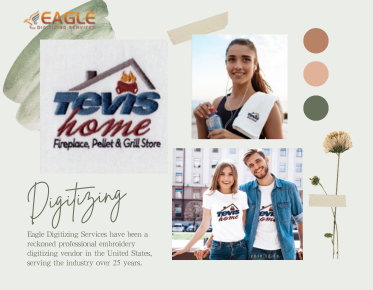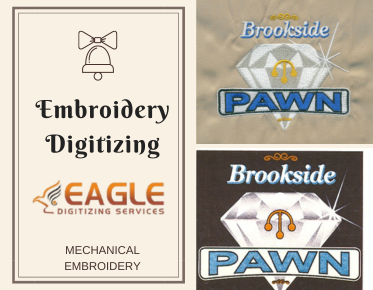Fueling Business Growth: Leveraging Embroidery and Vector Art Design Effectively
In today's competitive market, businesses must constantly evolve to capture the attention of their audience. One of the most compelling ways to achieve this is through creative design. While digital marketing strategies and sleek websites play a role, the tactile and visual appeal of embroidery and vector art can set a brand apart. By leveraging these art forms, businesses can enhance their brand identity, create memorable experiences, and drive growth. Read Here are Some Things That You Should Know When It Comes To Embroidery Digitizing!
Why Creative Design Matters in Business
Creative design isn't just about making things look good; it's about communicating a message and creating a connection. Effective design can evoke emotions, tell stories, and differentiate a brand from its competitors. In an era where consumers are bombarded with information, a well-designed logo or a beautifully embroidered piece can leave a lasting impression. Creative design helps businesses to:
● Establish a unique brand identity
● Build customer loyalty
● Convey professionalism and quality
● Stand out in a crowded marketplace
How Embroidery Enhances Brand Identity
Embroidery can significantly enhance brand identity by adding a touch of elegance and sophistication. When a logo or design is embroidered onto a product, it not only looks premium but also feels premium. This tangible quality can elevate a brand's perceived value and create a stronger emotional connection with customers.
Creating Custom Logos with Embroidery
Custom logos embroidered on apparel or accessories make a powerful statement. They convey a sense of exclusivity and attention to detail. Embroidery allows for intricate designs and color combinations, ensuring that a brand's logo is presented in the best possible light. This customization helps businesses to:
● Reinforce brand recognition
● Create a consistent brand image
● Enhance the perceived value of products
The Texture and Tangibility of Embroidered Designs
The texture of embroidered designs adds a unique sensory dimension to branding. The raised threads create a tactile experience that printed designs can't match. This tangibility can make branded products more memorable and desirable, encouraging customers to interact with and cherish them.
Embroidery on Different Materials: What Works Best?
Embroidery works best on sturdy fabrics that can support the weight and tension of the stitches. Common materials include cotton, denim, and polyester. However, more delicate fabrics like silk or satin can also be embroidered with the right techniques. Understanding the properties of different materials helps in choosing the best fabric for the intended use, ensuring durability and aesthetic appeal.
Using Vector Art for Dynamic Branding
Vector art's versatility makes it ideal for dynamic branding. Its scalability ensures that logos and designs look crisp and professional, whether displayed on a tiny social media icon or a massive trade show banner. Vector art can also be easily modified, allowing for quick updates and adaptations to different marketing campaigns.
Scalable and Versatile: The Power of Vector Graphics
The power of vector graphics lies in their ability to be resized and reshaped without any loss of quality. This makes them an essential tool for businesses that need consistent branding across multiple platforms. Vector graphics can be used for:
● Digital marketing materials
● Print advertisements
● Product packaging
● Website graphics
Crafting Modern Logos with Vector Art
Modern logos often rely on clean, minimalist designs that are easily recognizable and versatile. Vector art is perfect for this style, offering crisp lines and bold colors that stand out. By using vector art, businesses can create logos that are not only aesthetically pleasing but also practical for a variety of uses.
Vector Art in Digital Marketing Campaigns
Vector art plays a crucial role in digital marketing campaigns. Its clarity and scalability make it ideal for online advertisements, social media posts, and email newsletters. The ability to quickly adjust vector designs allows businesses to tailor their marketing materials to different audiences and platforms, maximizing their reach and impact.
Combining Embroidery and Vector Art
Combining embroidery and vector art can create hybrid designs that offer the best of both worlds. This approach allows businesses to maintain the precision and modern appeal of vector art while adding the texture and tangibility of embroidery. Hybrid designs can be particularly effective for:
● Premium products
● Limited edition items
● Special promotional materials
Maximizing Visual Impact with Hybrid Designs
Hybrid designs can maximize visual impact by combining different textures and effects. For example, an embroidered logo on a jacket paired with vector graphics on the accompanying marketing materials can create a cohesive and compelling brand presence. This approach ensures that the brand stands out both physically and digitally.
Balancing Traditional and Modern Aesthetics
Balancing traditional and modern aesthetics can help a brand appeal to a wider audience. The timeless quality of embroidery combined with the sleek, contemporary look of vector art can create a unique and memorable brand identity. This balance allows businesses to honor their heritage while embracing modern trends.
Practical Applications for Businesses
There are numerous practical applications for embroidery and vector art in business. From apparel and uniforms to corporate gifts and marketing materials, these design techniques can enhance a brand's visibility and reputation.
Uniforms and Apparel: Stitching Your Brand Everywhere
Embroidered uniforms and apparel ensure that a brand is represented wherever employees go. This not only promotes the brand but also instills a sense of pride and unity among staff. Custom apparel can also be used as promotional items, helping to spread the brand's message far and wide.
Corporate Gifts: Personalized and Memorable
Corporate gifts that feature custom embroidery or vector art designs can leave a lasting impression. Personalized gifts show thoughtfulness and attention to detail, making them more memorable for recipients. These gifts can range from embroidered tote bags to custom-designed stationery.
Marketing Materials: Eye-Catching and Professional
Marketing materials that incorporate vector art can catch the eye and convey professionalism. High-quality graphics enhance the visual appeal of brochures, flyers, and posters, making them more effective at attracting and retaining customers' attention.
Getting Started with Embroidery and Vector Art
For businesses looking to get started with embroidery and vector art, it's important to choose the right tools and resources. This includes selecting appropriate software, finding skilled designers, and budgeting for quality.
Choosing the Right Tools and Software
Choosing the right tools and software is crucial for creating high-quality embroidery and vector art designs. Software like Adobe Illustrator and CorelDRAW are popular choices for vector art, while embroidery machines and digitizing software are essential for producing detailed embroidered designs.
Finding Skilled Designers and Embroiderers
Finding skilled designers and embroiderers can make a significant difference in the quality of the final product. Working with professionals who have experience in these fields ensures that designs are executed flawlessly and meet the brand's standards.
Cost Considerations: Budgeting for Quality
Budgeting for quality is essential when investing in embroidery and vector art. While high-quality designs and materials may come at a higher cost, the return on investment in terms of brand perception and customer loyalty can be substantial. It's important to consider the long-term benefits of quality design.
Tips for Effective Design Integration
Integrating embroidery and vector art effectively requires careful planning and execution. Ensuring consistency across platforms, adapting designs for different media, and measuring the impact on the business are key steps in this process.
Maintaining Consistency Across Platforms
Maintaining consistency across platforms ensures that a brand's message is clear and cohesive. This involves using the same colors, fonts, and design elements in both embroidered products and digital graphics. Consistency builds trust and recognition among customers.
Adapting Designs for Different Media
Adapting designs for different media is crucial for maximizing their impact. Embroidered designs may need to be simplified for clarity, while vector graphics can include more intricate details. Understanding the strengths and limitations of each medium helps in creating effective designs.
Measuring the Impact on Your Business
Measuring the impact of embroidery and vector art on a business involves tracking customer engagement and evaluating the return on investment (ROI). This helps in understanding the effectiveness of the designs and making informed decisions for future projects.
Tracking Customer Engagement
Tracking customer engagement can provide insights into how well designs are resonating with the audience. This can include monitoring social media interactions, website traffic, and sales data. Engaging designs can lead to higher customer satisfaction and loyalty.
Evaluating ROI from Creative Design Investments
Evaluating ROI from creative design investments involves comparing the costs of design and production with the benefits gained, such as increased sales and brand recognition. High-quality designs can lead to long-term gains, making them a worthwhile investment.
Future Trends in Embroidery and Vector Art
Emerging trends in embroidery and vector art are shaping the future of creative design. These trends include new technologies and techniques, as well as the growing popularity of personalized design.
Emerging Technologies and Techniques
Emerging technologies and techniques are revolutionizing the field of embroidery and vector art. Advances in embroidery machines and digital design software are allowing for more intricate and precise designs. These innovations are expanding the possibilities for creative design.
The Growing Popularity of Personalized Design
Personalized design is becoming increasingly popular as consumers seek unique and custom-made products. Businesses can capitalize on this trend by offering personalized embroidered items and customized vector graphics, catering to the demand for individuality.
Embroidery and vector art can serve as powerful catalysts for business growth. By encouraging experimentation and creativity, businesses can create distinctive and memorable brand identities. These art forms offer a unique way to stand out in a competitive market, inspiring businesses to innovate and thrive.
Take the next step in your design journey by exploring the possibilities of embroidery and vector art in USA. Invest in quality design, work with skilled professionals, and create designs that truly represent your brand. By doing so, you'll not only enhance your brand identity but also set your business on a path to success.


